Superset Workouts: Twice The Gains In Half The Time
Find out how to train more efficiently and use our superset workout plan to build a lean, defined torso in just four weeks
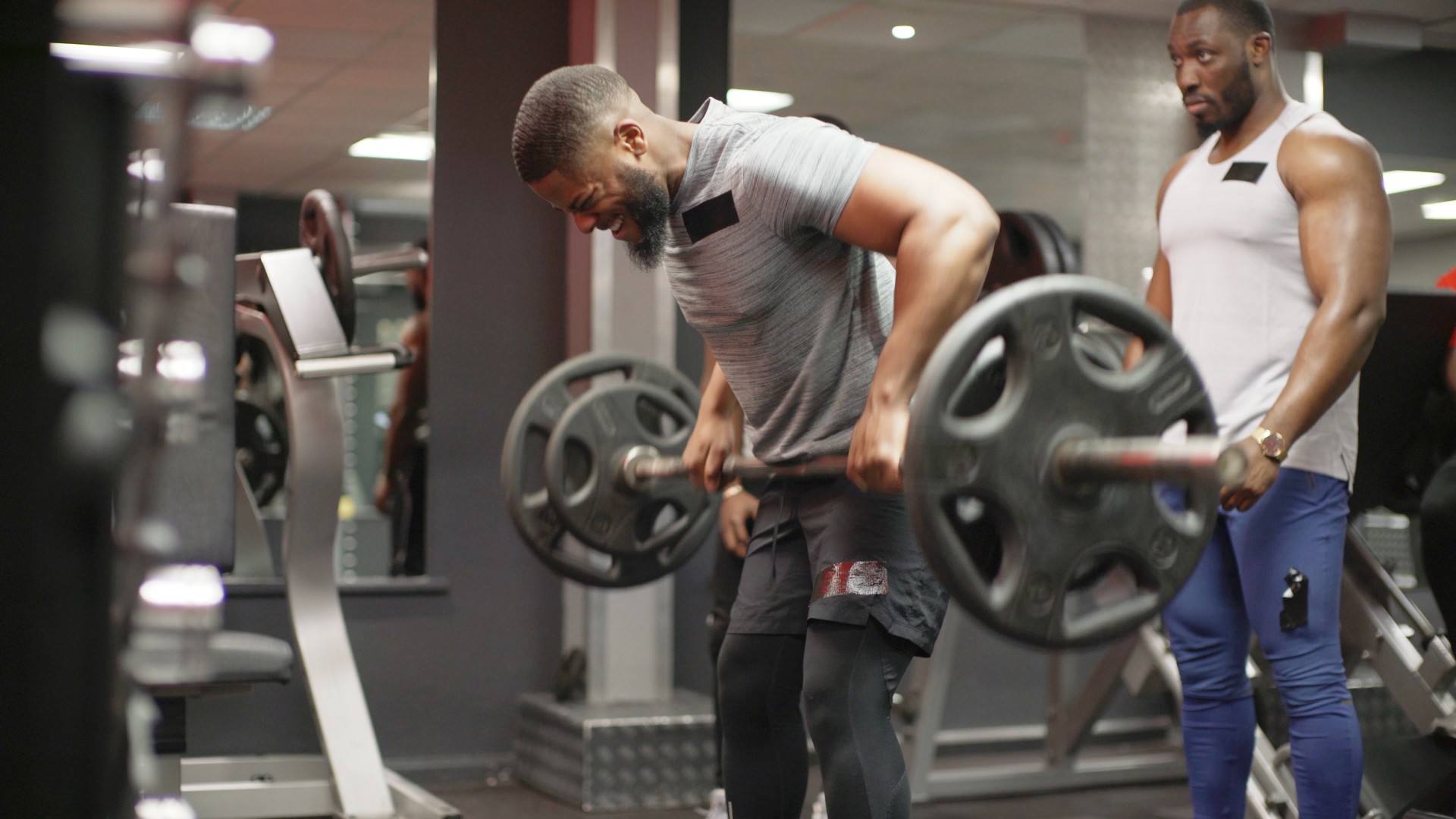
There are two main reasons to add supersets into your training. The first is that they are a great way to increase the difficulty of your workouts and overload your muscles to promote greater gains. The second is that they are extremely efficient, so you’ll be able to complete effective workouts in less time.
However, both of these benefits are down to significantly reducing your rest between exercises, often to the point where you get no meaningful rest at all between some combinations of moves. This means that beginners should approach supersets with caution, because they are so challenging and require you to switch between exercises rapidly while still maintaining good form. If you are fairly new to the gym and looking for ways to increase the difficulty of your exercises then it’s advisable to make small step changes to the variables of weight, reps, sets, tempo or, of course, rest. Drop your rest periods from 90 seconds to 60 and you’ll feel it the next day, so make sure you’re able to handle that before tackling supersets.
For the experienced gym-goer, there are several ways to use supersets in your training, but there are a couple of standard features. The first is that commonly you get little if any rest in between two sets of exercises, and the second is that you combine exercises to increase their effect. This can be through overloading the muscles targeted with similar exercises, or hitting a variety of body areas quickly by doing complementary moves that work opposing muscle groups.
The standard form of superset training involves combining two moves, where you do a set of the first exercise, then go straight into a set of the second, then rest, before going back to the first exercise and continuing that pattern until you’ve completed all the specified sets. However, you can increase the exercises involved by doing tri-sets (three moves) or even giant sets, where you knock out four moves in a row. Needless to say that last one is for accomplished gym-goers. Below you’ll find more in-depth explanations of the different types of supersets and some examples of workouts you can try.
Types Of Superset Workouts
Antagonistic Supersets
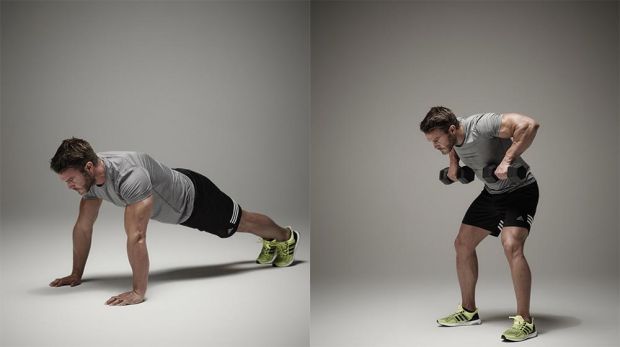
What are they? Supersets that work a muscle and then its opposite number. The biceps-triceps double is a classic, since it’s fairly easy to do, but chest-back and quad-hamstring supersets also work.
What are they good for? They’re a time-saver, but there’s another bonus: thanks to an effect known as reciprocal innervation, as one muscle group works the other (antagonistic) group relaxes, improving recovery. There’s also some evidence that blood flow to the working muscle’s increased, meaning you’ll be able to lift more weight and get more bang for your buck in each move.
What should you be wary of? For best results with big compound movements, make sure you’re working your antagonist muscles through similar planes of motion: for instance, pair a bench press with a bent-over row or pull-ups with an overhead press. Also, don’t sprint straight from one move to the next – a few seconds’ rest might help you shift more weight.
Sign up for workout ideas, training advice, reviews of the latest gear and more.
Expert tip “Make sure you’re squeezing the antagonist muscle at the end of the movement – for instance, the biceps at the top of a dip, or the triceps at the bottom of a curl,” says personal trainer Joel Dowey. “That way, you ensure full lengthening of the target muscle before the next rep. The same goes for quads and hams, or any other muscle pair.”
Agonist Supersets
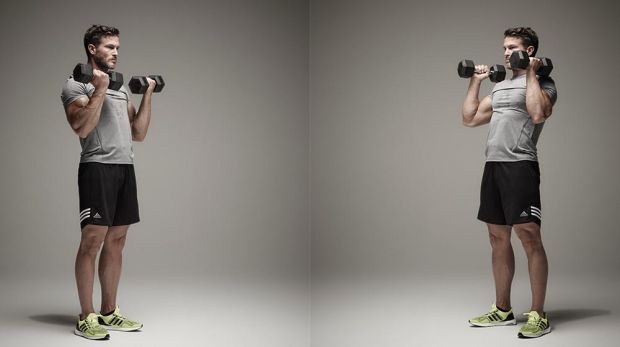
What are they? A full-on assault on a single muscle group, prompting your muscles into growth by exhausting them. Classics include the old dumbbell bench press/flye double-whammy for the chest and the hamstring curl/Romanian deadlift for legs, but mechanical drop-sets – like switching from a normal to a hammer grip during curls – can work too.
What are they good for? Building muscle. Getting stronger means trying to stay fresh, but for more mass you’ll want to exhaust your muscles. This also means minimising your rest between the two exercises so your muscles can’t fully recover.
What should you be wary of? “I keep agonist superset to larger muscle groups – quads, lats or chest – because smaller muscles generally don’t respond as well,” says Dowey. “My current favourite is leg extensions into Bulgarian split squats using the leg pad of the extension machine – these allow the rear leg to be stretched slightly while the front leg is under tension.”
Expert tip “With these, it’s worth loading the muscle at different lengths,” says Dowey. “Pick an exercise that will load the muscle at its longest, such as seated cable rows leaning your torso forward at all times, then shorten it, so the same move with an upright torso keeping strict form. The weight will have to change but you’ll work the muscle hard at both extremes. Alternatively, switch between a compound and an isolation exercise to combine intensity with total volume for that muscle group.”
Tri-Sets
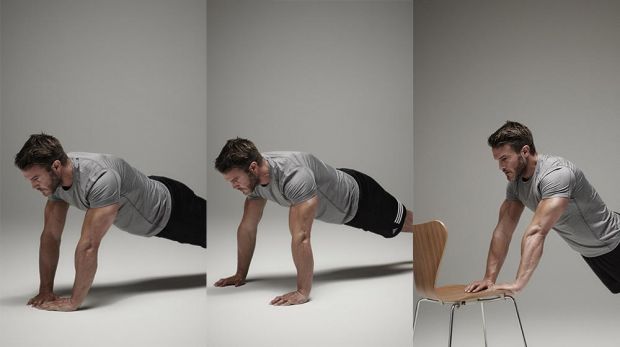
What are they? The clue’s in the name. Technically, a tri-set is any three exercises done back to back, with minimal rest in between. There are two main options: use them all to target the same muscle group, or aim for slightly different ones, allowing one muscle to relax while you’re working others.
What are they good for? Maximising training time and kit. If you need to get in and out of the gym in half an hour, a carefully targeted tri-set can work multiple muscle groups in a few minutes, giving you a full-body workout.
What should you be wary of? Overtraining. If you’re relatively new to the gym, it’s easy to push yourself too hard by hammering every muscle group – or by blasting one into the ground. If you overdo it and end up with delayed onset muscle soreness (DOMS), do some cardio that targets the affected area – rowing if you’ve ruined your lats, say – to get the blood flowing and aid recovery.
Expert tip “Use tri-sets that take advantage of a single bit of kit and you won’t have to fight for dumbbells in a crowded gym,” says Geoff Clement of Pure Fitness. “On a cable machine, for instance, you might triple up with a face pull, a triceps extension and a straight-arm pull-down.”
Giant Sets
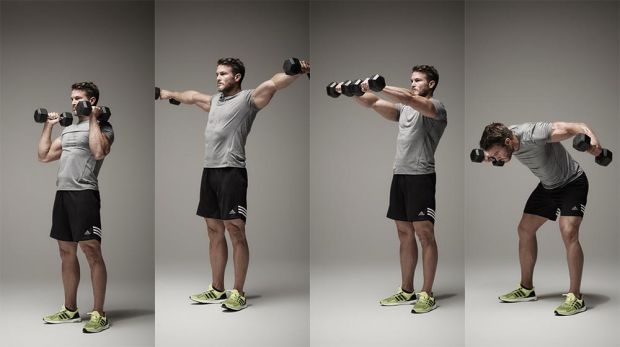
What are they? Four or more exercises done with minimal rest, aimed at overloading a single muscle group for super-sized gains – or working the whole body to maximise fat burning.
What are they good for? Completely exhausting a single muscle group in minimal time. If you’ve got a relatively empty gym and the mental fortitude to go after it, they’re a great way to maximise the production of growth hormone.
What should you watch out for? A drop in intensity. The more exercises you include, the easier it is to take your foot off the pedal during the final few. To stay strong, do compound exercises first, and finish with the least taxing movements: for your shoulders, for instance, you might do a dumbbell hammer press, lateral raise, front raise and reverse flye. It’s also worth noting that giant sets are definitely an advanced training protocol. This isn’t something you should have a go at the first time you walk into a gym.
Expert tip “Don’t use giant sets every week,” says Clement. “Instead, save them as a jolt when you hit a plateau in your training, and use them once every few weeks.”
Suggested Superset Pairs
Perform these moves back-to-back for four sets of eight reps.
1 Pull-up and triceps dip
Why This superset will add serious size to your arms
How For the pull-ups, hang from a bar with an overhand grip. Squeeze your lats to pull your chest up towards your hands then lower until your arms are straight again. That’s one rep. After eight reps, move on to parallel bars. Keeping your chest up, bend your elbows to lower yourself as far as you can, then press back up to the start. That’s one rep. Rest for 60 seconds after the final rep, then repeat for a total of four supersets.
2 Back squat and front squat
Why This superset will send your heart-rate rocketing and build bigger legs
How For the back squat stand tall with the barbell across the back of your shoulders. Keeping your chest up and core braced, squat down until your thighs are parallel to the ground, then stand back up. That’s one rep. After eight reps, re-rack the bar, then lift it again so it’s across the front of your shoulders. Follow the same form as with the back squat. That’s one rep. Rest for 60 seconds after the final rep, then repeat for a total of four supersets.
3 Overhead press and bent-over row
Why This superset will add mass to your shoulders and upper back
How For the overhead press hold a barbell across the front of your shoulders. Press the bar directly overhead until your arms are straight, then lower it to the start. That’s one rep. After eight reps, lower the bar to your thighs. From there, hinge forward from your hips with arms straight. Row the bar up towards your chest, leading with your elbows, then lower it under control. Rest for 60 seconds after the final rep, then repeat for a total of four supersets.
4 Deadlift and press-up
Why This superset works your heart harder by alternating blood flow between your upper and lower body
How Stand in front on a barbell, then squat down and grip it with both hands. With your chest up push through your heels to raise the bar. Push your hips forward at the top, then reverse the movement. That’s one rep. After eight reps, get into the press-up position with hands under your shoulders. Bend your elbows to lower your chest, then press back up. That’s one rep. Rest for 60 seconds after the final rep, then repeat for a total of four supersets.
More Superset Workouts
- This Dumbbell Superset Workout Will Develop Athletic Power
- Kettlebell Superset Workout For Superior Results
- Superset Back Workouts To Add Major Muscle Quickly
- The Superset Arms Workout For Men Who Want Bigger Biceps And Triceps
- The Ultimate Superset Shoulder Workout
- Tri Hard: A Tough Superset Triceps Workout
Upper-Body Superset Training Plan
This four-week workout is designed around supersets and tri-sets. These will create the stimulus for your body to add maximum muscle mass across your torso, while also producing the intensity for your body to burn away excess body fat. The result will be a wider chest, back and shoulders, and bigger arms.
How The Plan Works
Following this plan couldn’t be easier. There are three workouts a week: workout 1 targets your chest and back, workout 2 your legs and shoulders, and workout 3 your biceps and triceps. Do the three workouts in that order, leaving at least a day’s rest between sessions to give your muscles enough time to recover so that you can build new lean muscle mass as well as burning away your spare tyre.
Workouts 1 and 2 both begin with a superset, with the two exercises labelled 1A and 1B. Do all the reps of exercise 1A, rest for no more than 30 seconds, then do all the reps of exercise 1B and rest for 60 seconds. Repeat this for a total of five supersets. Then move on to the second part of the workout: a tri-set made up of three moves, called 2A, 2B and 2C, which are performed back-to-back. Do all the reps of move 2A, rest for ten seconds, do all the reps of 2B, rest for ten seconds, then do all the reps of 2C and rest 60 seconds. Repeat this for a total of three tri-sets.
Workout 3 is a bit different and made up of two tri-sets: the first works your biceps, and the second targets your triceps. Stick to the sets, reps and rest periods detailed.
To get the full effect from these workouts you need to stick to the 2010 tempo code for each exercise. This means you take two seconds to lower the weight, don’t pause at the bottom of the move, take one second to lift the weight again, then no pause at the top before lowering. Each rep will take a total of three seconds, and this accumulation of time under tension increases your heart rate to burn body fat and break down muscle tissue so it’s rebuilt bigger and stronger. Keep each rep smooth and controlled so your muscles – not momentum – do the work, and move through a full range of motion.
Workout 1: Chest And Back
1A Bench press
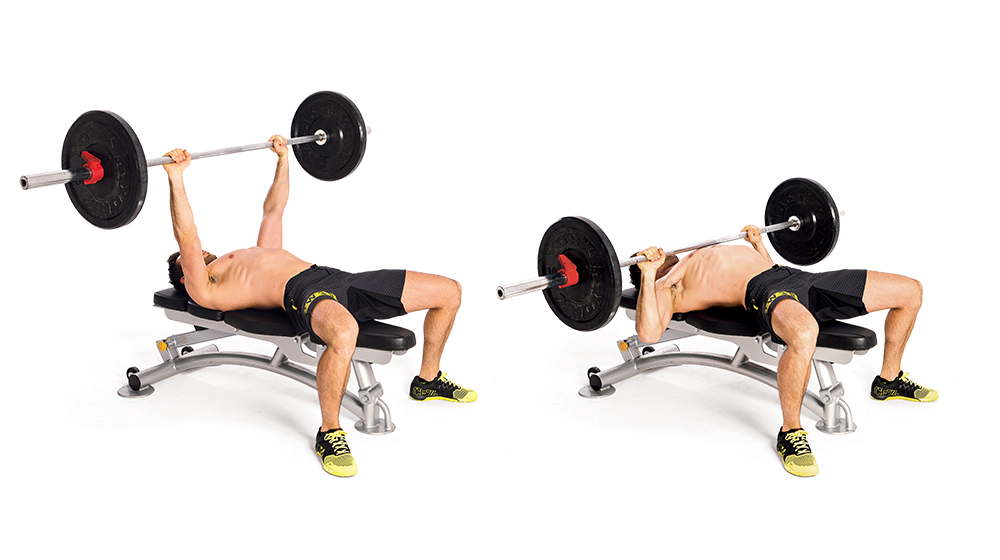
Sets 5 Reps 8 Rest 30sec
Lie on a flat bench holding the bar with an overhand grip with your hands slightly wider than shoulder-width apart. Brace your core and press your feet into the ground, then lower the bar towards your chest. Press it back up to the start.
1B Pull-up
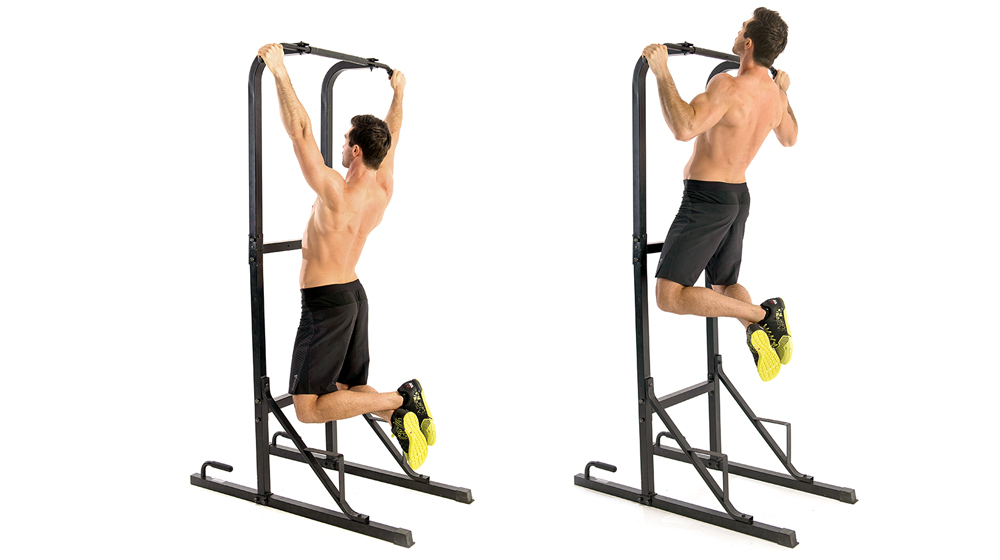
Sets 5 Reps 8 Rest 60sec
Hold a pull-up bar using an overhand grip with hands slightly wider than shoulder-width apart. Brace your core, then pull yourself up until your sternum touches the bar. Then lower until your arms are straight again.
2A Incline dumbbell bench press
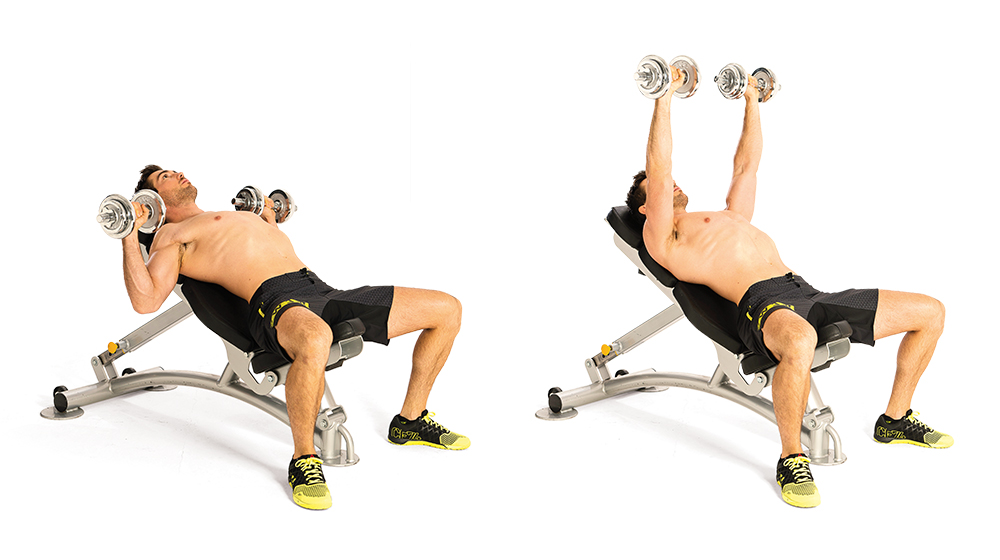
Sets 3 Reps 12 Rest 10sec
Lie on an incline bench with a dumbbell in each hand at shoulder height. Brace your core and press your feet into the ground, then press the weights up until your arms are straight. Lower them back to the start.
2B Incline dumbbell flye
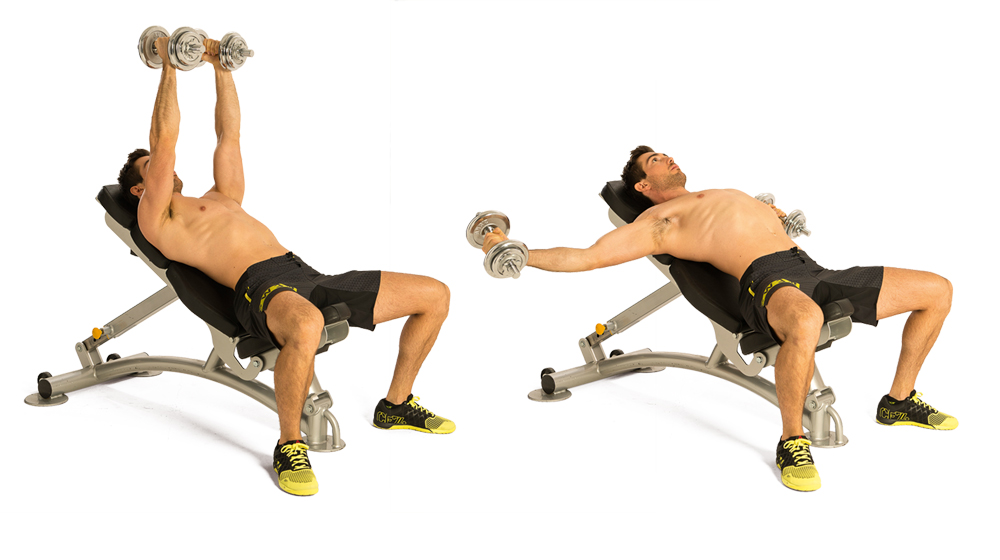
Sets 3 Reps 12 Rest 10sec
Lie on an incline bench holding a dumbbell in each hand above your face, palms facing and with a slight bend in your elbows. Lower them to the sides, then bring them back to the top.
2C Single-arm row
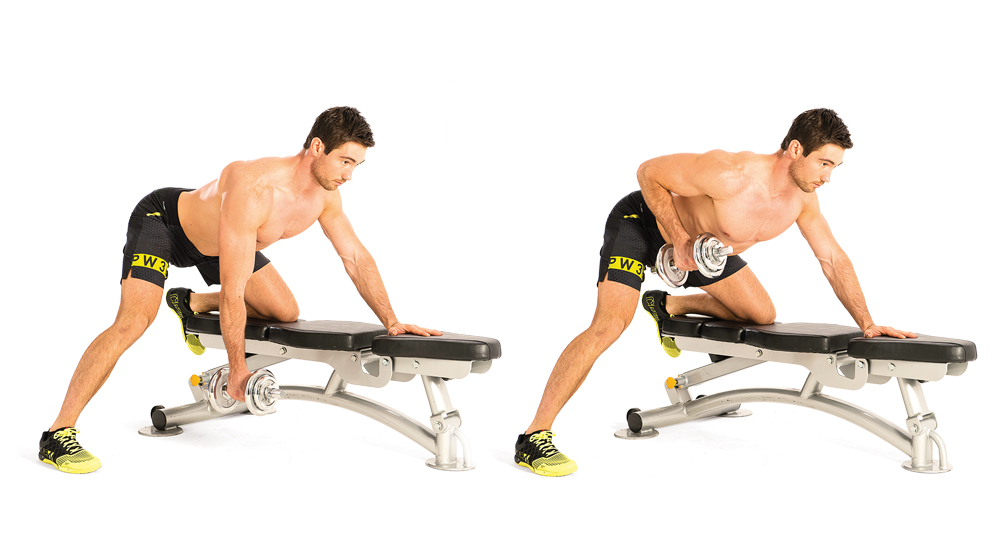
Sets 3 Reps 12 each side Rest 60sec
Place one knee on the bench and plant the other foot wide. Brace your core and lift the weight to the side of your chest, keeping your elbow tucked in, then lower slowly. Complete all reps on one side, then the other.
Workout 2: Legs And Shoulders
1A Dumbbell front squat
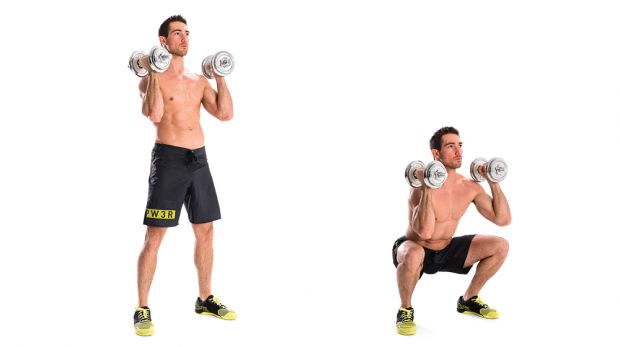
Sets 5 Reps 12 Rest 30sec
Stand tall holding a dumbbell in each hand at shoulder height with palms facing. Keeping your chest up, core braced and back straight, squat down as deeply as you can, then drive through your heels to return to the start.
1B Dumbbell lunge
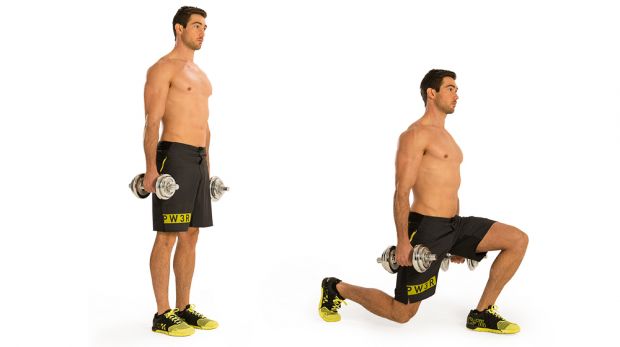
Sets 5 Reps 12 each side Rest 60sec
Stand tall holding a dumbbell in each hand. Keeping your chest up, take a big step forward with your right foot, bending both knees until they’re at 90˚. Drive back through your front foot to return to the start, then repeat the movement on your other leg.
2A Overhead press
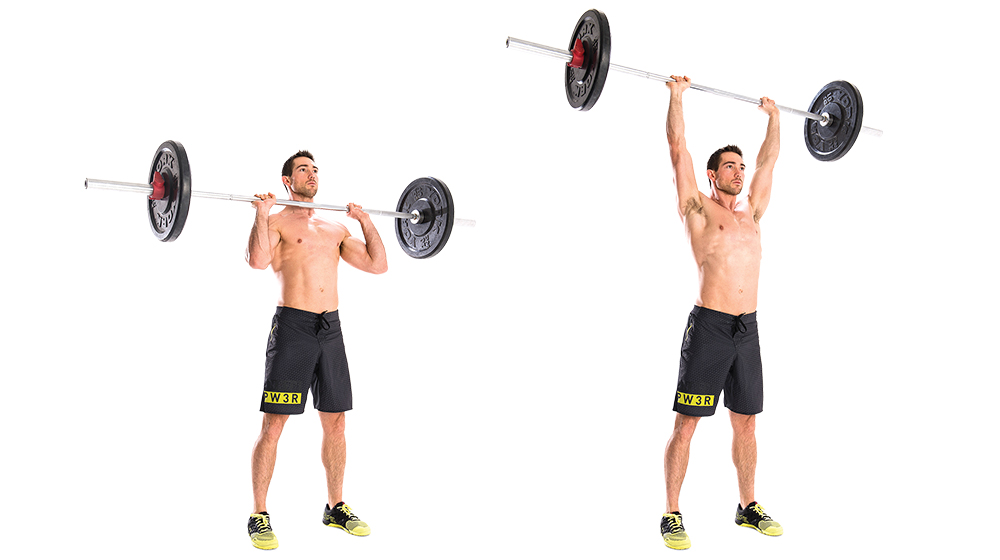
Sets 3 Reps 12 Rest 10sec
Stand tall with your feet shoulder-width apart holding a barbell across the top of your chest with hands slightly wider than shoulder-width apart. Keeping your chest up and core braced, press the bar overhead until your arms are straight, then lower it back down.
2B Dumbbell lateral raise
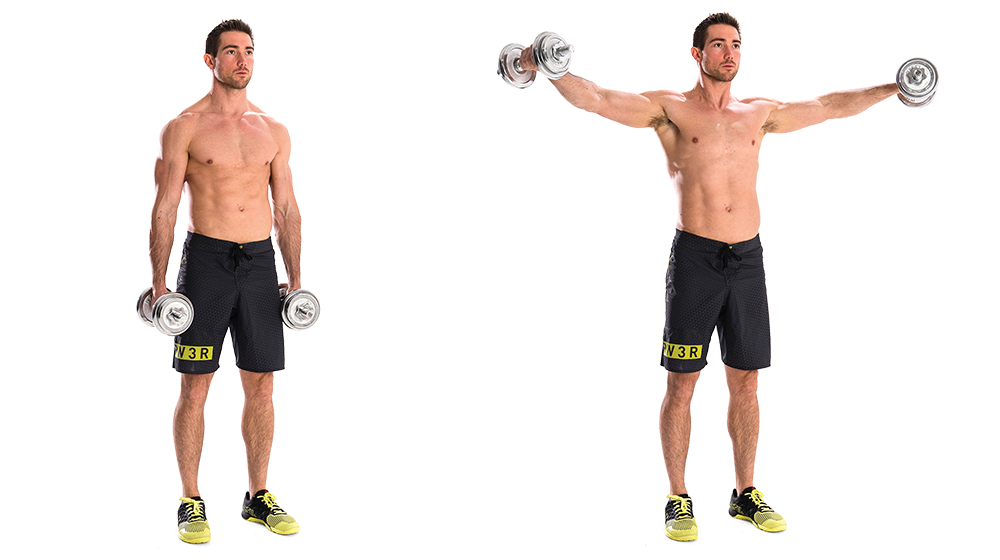
Sets 3 Reps 12 Rest 10sec
Stand tall holding a light dumbbell in each hand with palms facing each other. Keeping your chest up, core braced and a slight bend in your elbows, raise your arms out to the sides until the weights are at shoulder height, then return to the start.
2C Dumbbell reverse flye
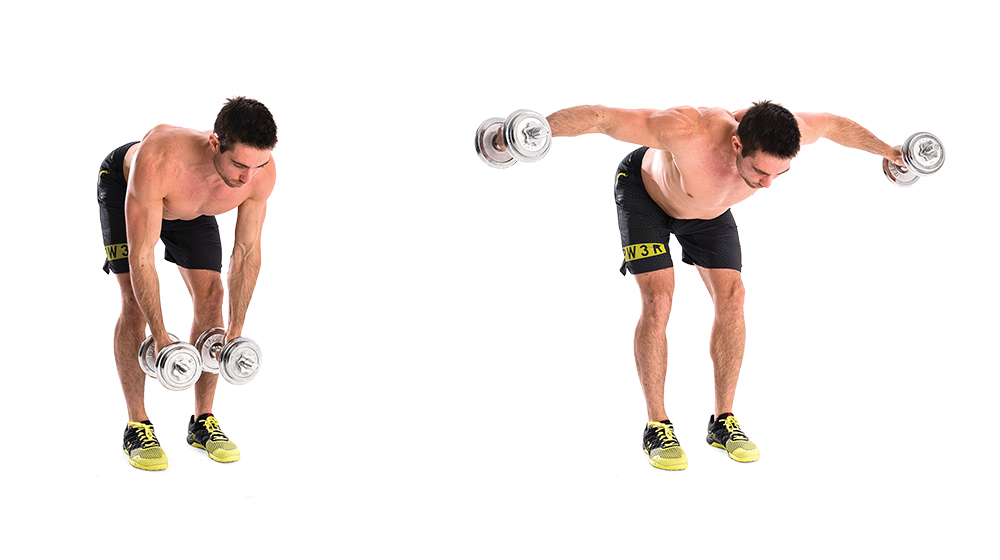
Sets 3 Reps 12 Rest 60sec
Hold a light dumbbell in each hand then bend forwards, hingeing at the hips. Keeping a slight bend in your elbows, raise your arms out until the weights are at shoulder height, turning your thumbs down at the top, then return to the start
Workout 3: Biceps And Triceps
1A Chin-up
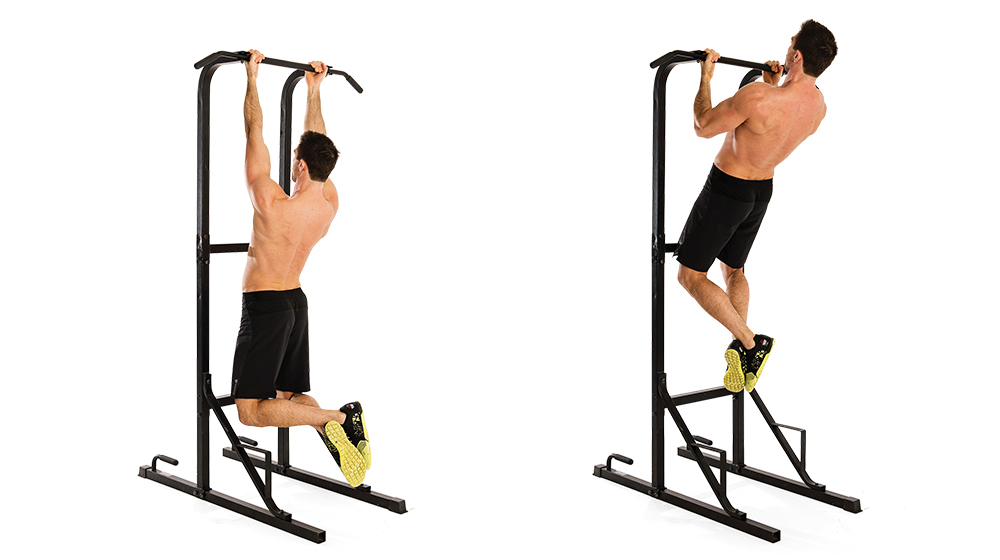
Sets 3 Reps 12 Rest 10sec
Hold a chin-up bar using a shoulder-width underhand grip. Brace your core, then pull yourself up until your chin is higher than the bar, keeping your elbows tucked in to your body. Lower until your arms are straight again.
1B Reverse-grip bent-over row
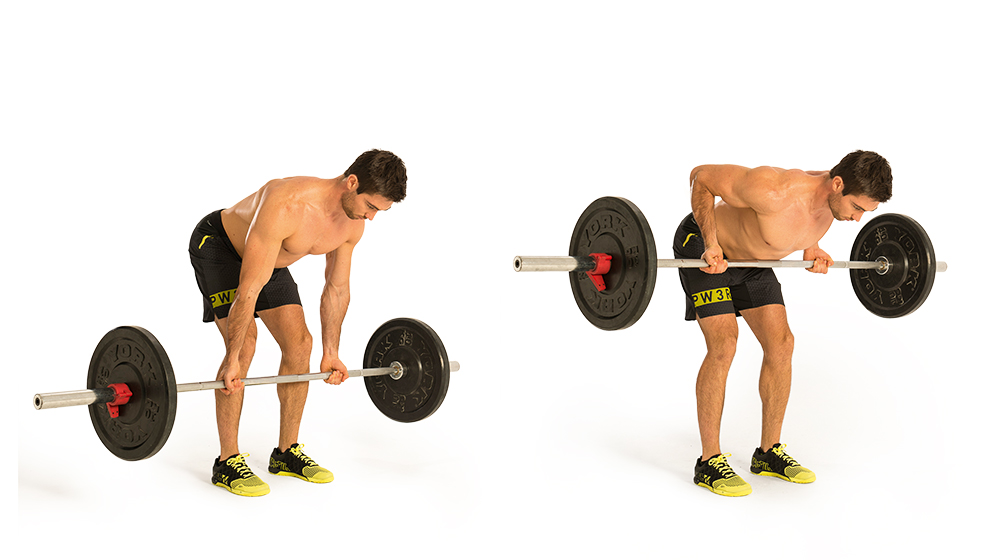
Sets 3 Reps 12 Rest 10sec
Hold a bar using a shoulder-width underhand grip just outside your legs. Bend your knees slightly, then hinge forward from your hips, keeping your shoulder blades back. Pull the bar up towards your sternum, leading with your elbows, then lower it again.
1C Barbell biceps curl
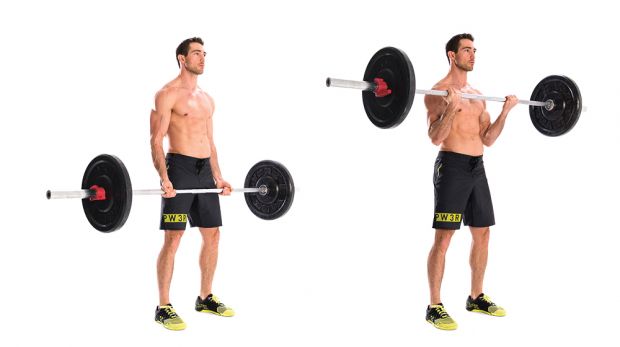
Sets 3 Reps 12 Rest 60sec
Hold a barbell with an underhand grip with your hands shoulder-width apart. Keeping your chest up, core braced and elbows tucked in to your sides, curl the bar up to your chest, squeezing your biceps as you go. Lower back to the start.
2A Seated dumbbell shoulder press
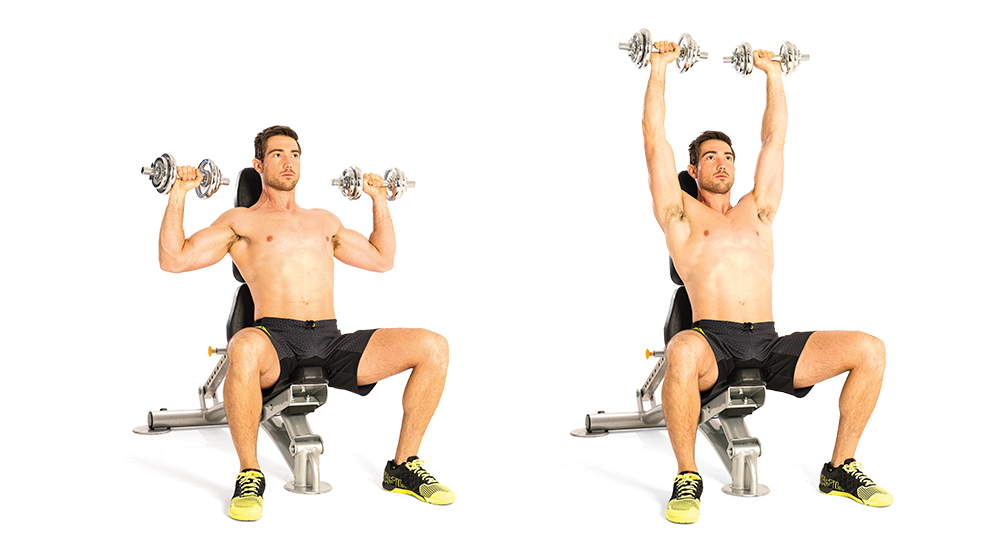
Sets 3 Reps 12 Rest 10sec
Sit on an upright bench holding a dumbbell in each hand at shoulder height, palms facing forward. Keeping your chest up, press the weights directly overhead until your arms are straight, then lower back to the start.
2B Dumbbell bench press
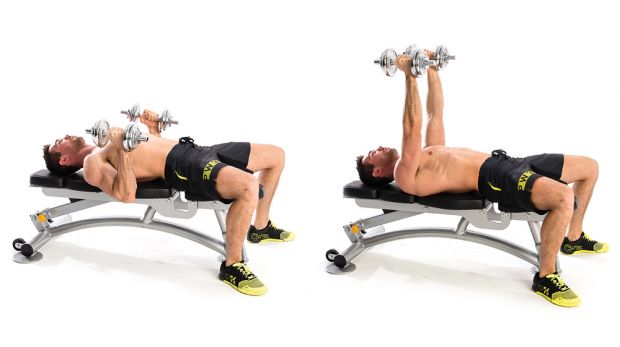
Sets 3 Reps 12 Rest 10sec
Lie on a flat bench, holding dumbbells by your shoulders with palms facing. Drive your feet into the floor and press the weights straight up, then lower them slowly back to the start.
2C Diamond press-up
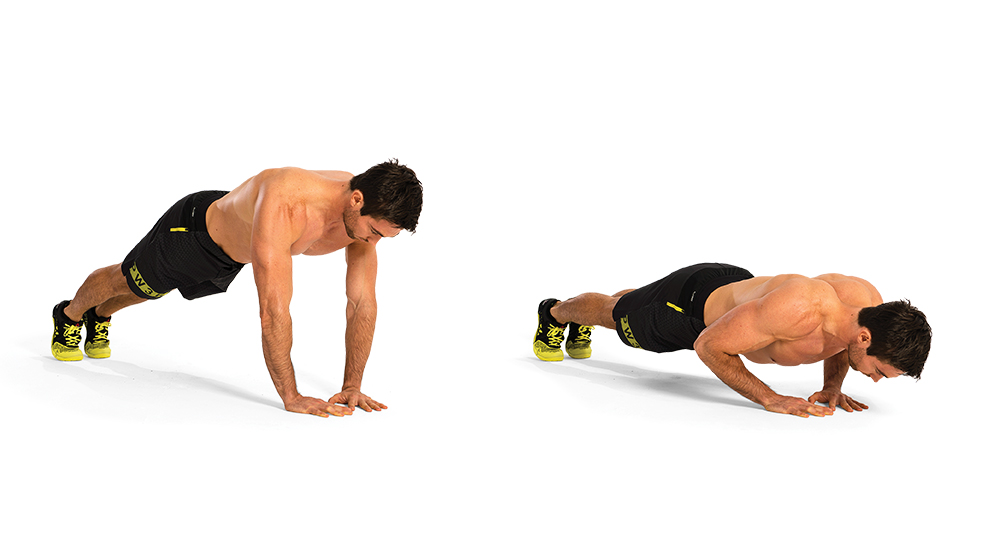
Sets 3 Reps 12 Rest 60sec
Start in a press-up position but with your thumbs and index fingers touching to form a diamond. Keeping your hips up and core braced, bend your elbows to lower your chest towards the floor. Push down through your hands to return to the start.
From 2008 to 2018, Joel worked for Men's Fitness, which predated, and then shared a website with, Coach. Though he spent years running the hills of Bath, he’s since ditched his trainers for a succession of Converse high-tops, since they’re better suited to his love of pulling vans, lifting cars, and hefting logs in a succession of strongman competitions.

